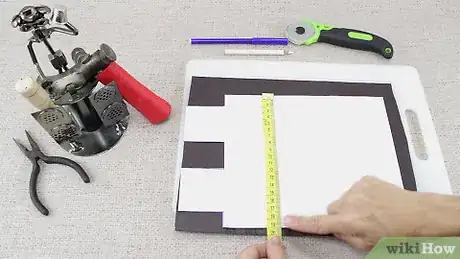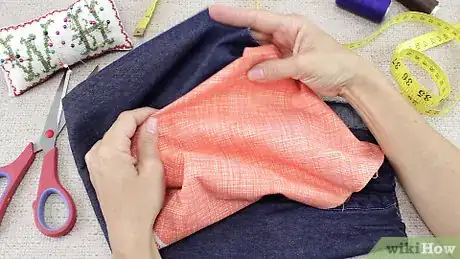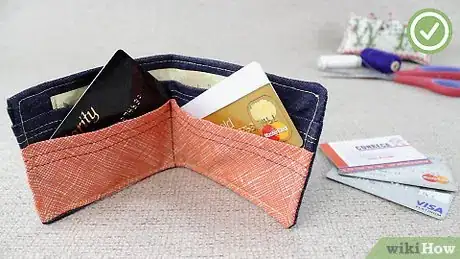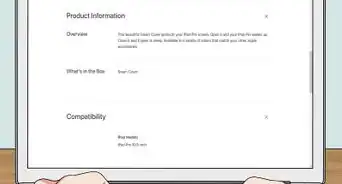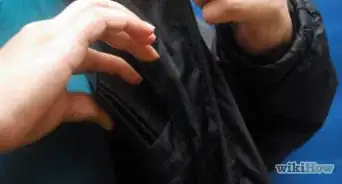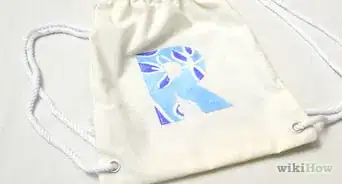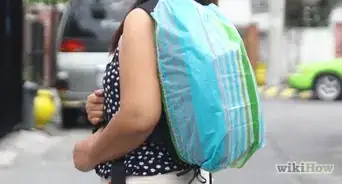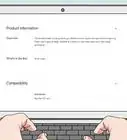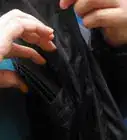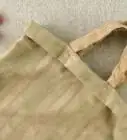This article was co-authored by Mallika Sharma. Mallika Sharma is a Certified Leather Care Technician and the Founder of The Leather Laundry, a niche spa service for luxury leather gear in India. Mallika specializes in leather cleaning, coloring, repairing, and restoring for shoes, handbags, jackets, wallets, belts, and sofas. She holds a Master’s degree in Finance and Investment from the University of Edinburgh Business School. Mallika is a certified Professional Leather Care Technician and trained with the globally reputed leather care company, LTT in the United Kingdom.
This article has been viewed 115,997 times.
Leather and fabric wallets are deceivingly simple to make with the right materials and techniques. The great part about creating your own wallet is that you can add enough pockets and pouches for all of your money and cards. Plus you can choose colors and materials that suit your personal taste. Stitching together an elegant leather wallet isn't too difficult as long as you have the right cutting and punching tools along with a needle, thread, and basic hand-sewing abilities. Or you can make a softer canvas wallet by hand-sewing or machine-sewing it together.
Steps
Hand-Sewing a Leather Wallet
-
1Cut out a paper pattern for your wallet. Search online and in leatherworking books for your favorite wallet pattern, then print it out to scale.[1] Or devise your own simple pattern with a few simple rectangles, drawn out in pencil on cardstock or kraft paper. Label each piece and then cut them out of cardstock or craft paper.
- If you're creating your own pattern, the main wallet body piece should be roughly 11 in (28 cm) long by 7.5 in (19 cm) wide.
- This main piece will also have 2 snap tabs for closures. Each tab will be a square measuring 2 in (5.1 cm) on all sides. Draw these squares on the left side of the wallet body piece, about 0.5 in (1.3 cm) from the top and bottom with about 2.5 in (6.4 cm) of space in between them.
- Each card pocket piece should measure about 4 in (10 cm) long by 2 in (5.1 cm) wide. Make between 1 and 3 card pockets for the right side of your wallet.
- If you're adding a change pocket, make this pattern piece about 3 in (7.6 cm) by 3 in (7.6 cm).
-
2Trace the pattern pieces onto the leather. Place 1 pattern piece onto the leather and trace around the outside of it with chalk or a colored pencil. Then move on to trace the rest of the pattern pieces, 1 at a time.[2]
- A supple piece of vegetable-tanned cowhide leather would be suitable for this project, although other animal leathers would also work.
- Order a small piece, no more than 1 to 2 ft (0.30 to 0.61 m) long, from an online retailer, a local fabric store that carries leather, or a specialty leather retailer.
- Leather thickness is measured in ounces. Choose a leather weight between 3 to 6 oz (85 to 170 g) for your wallet. A lower weight will result in a slimmer and less bulky wallet.
- Feel free to use the same piece of leather for the entire wallet or switch it up with different leathers for the pockets.
Advertisement -
3Cut the leather pieces out using a rotary blade. Place your leather on a cutting surface, with the marked lines facing up. For the cleanest cut lines, place a metal ruler against one of the pattern line you just traced. Press a sharp rotary blade into the leather and draw it along the side of the ruler. Cut along each line until all of the pattern pieces are free.[3]
- Move the blade slowly and be very careful not to slip.
- Keep in mind that this cut edge will be the finished edge of the wallet. Trim off any nicks along the cut edge before moving ahead.
- If you don't have a rotary blade, try a sharp utility knife instead.
- Either a self-healing cutting mat or a kitchen cutting board would be suitable surfaces to place the leather on before cutting it.
-
4Tape or pin the pockets in position on the wallet body. Lay the card pockets on top of one another so that the top 0.5 in (1.3 cm) of each pocket remains visible. Center this stack of pockets on the upper right quadrant of the wallet body. Place the 3 in (7.6 cm) square change pocket in the center of the upper left quadrant of the wallet body. Use masking tape or sharp metal push pins to hold the pockets in place.[4]
- If you're using pins, place one in each corner of the pockets. Note that this will puncture the leather so make sure that you have the layout correct.
- If you prefer to have more card pockets, just cut out a few more of these pieces instead of cutting out a change pocket. Stack them together and center them on the upper left quadrant of the wallet where the change pocket would otherwise go.
-
5Punch holes around the outside edge of each pocket and into the wallet body. Use either an awl, rotary punch, or a sharp metal push pin to punch holes through the pockets and down into the wallet body. The holes in the wallet body should be located directly beneath the holes in both sets of pockets. Continue until you've added holes to the bottom and sides of each pocket.[5]
- These holes will be where your needle passes through when you're sewing the wallet together.
- Don't punch holes along the top of the pockets. You also don't need to add holes along the outside edge of the wallet body during this step.
- Make sure you don't nudge the position of the taped or pinned-down pockets. You want to keep the holes in alignment across all the layers of leather.
- Place a piece of thick leather hide below your wallet if you're using a rotary punch. Doing so makes it easier to punch holes in the leather.
-
6Stitch the pockets to the wallet body with a needle and waxed thread. Thread a hand-sewing needle with waxed thread and knot the end. Use a basic straight stitch to hand sew each pocket to the body of the wallet, along the bottom and sides of each pocket. Finish it off with another knot when you're done. Then remove the tape or pins.[6]
- If desired, use a lighter to carefully burn the knot, melting the wax together for a more permanent hold.
- Start from the inside of the wallet (the side with the pockets) to hide the knot.
- Create the straight stitch by passing the thread in and out of the holes created with your rotary punch. Make sure the pocket holes are lined up with the holes in the wallet body as you do this.
- For added strength, complete 2 rows of stitching instead of just 1.
-
7Mark the position of your snap closure. To determine where to position each part of the snap closure, fold up your wallet to close it. Pinch the 2 square snap tabs together and fold them over the edge of the wallet. Press a push pin through the center of the tabs until it punctures the wallet body in the correct spot.[7]
- To fold your wallet, first fold in half lengthwise (so that the bottom half of the wallet body is folded up behind the top half containing the pockets). The 2 snap tabs should line up.
- Then close the wallet by folding it in half crosswise, touching the 2 sets of pockets together.
-
8Set each piece of the snap closure into the snap tabs and wallet body. You'll be using a metal set-in snap which consists of 4 parts: a front and back for the “female” half and a front and back for the “male” half of the snap. Use a metal cup and anvil to attach the components to the leather.[8]
- The snap cap will go on the of the bottom snap tab. The snap stud will go on the top snap tab.
- The cap and stud be attached, with the leather of both snap tabs sandwiched in between them. These pieces create the “male” part of the snap.
- The socket will go on the lower-right side of the wallet body, and the open prong will go on the other side of the leather, directly behind the socket. Together these pieces create the “female” part of the snap.
- You can purchase a kit for metal set-in snaps online. Make sure it comes with a metal cup and anvil that match the size of the snaps you're using.
-
9Punch holes along the bottom and sides of the wallet body. Once the set-in snaps are complete, fold the wallet back up lengthwise and pin or tape it in place. Then use your rotary punch, awl, or metal push pin to punch stitch holes along the bottom and both sides of the wallet body. The holes should go through both layers of leather.[9]
- Don't punch holes along the top of the wallet. By keeping this open you'll have a wide pocket for paper bills.
-
10Stitch the wallet body together through the holes. Use a basic straight stitch to sew the wallet body in half. Pass the needle and a waxed, knotted length of thread in and out of each hole until the wallet is completely stitched together.
- Start from the inside of the wallet, with the pockets facing up, to hide the knot. Burn the knot to melt the wax if you want a more durable knot.
- Stitch around 2 times for additional strength.
- If desired you could use sinew instead of thread to stitch along the outside of your wallet.
Hand or Machine-Sewing a Canvas Wallet
-
1Draw the wallet pattern pieces on paper and cut each piece out. You'll have a total of 4 rectangular pattern pieces. Draw 2 rectangles measuring 9.25 in (23.5 cm) long by 4 in (10 cm) tall. Label these pieces #1 and #2. Then draw a rectangle measuring 9.25 in (23.5 cm) long by 2.75 in (7.0 cm) tall. Label this piece #3. Finally, draw another rectangle measuring 9.25 in (23.5 cm) long by 3.75 in (9.5 cm) tall. Label this piece #4.[10]
- Use a ruler and pencil to measure and draw these pattern pieces onto cardstock or kraft paper.
-
2Select 1 or 2 wallet fabric(s). A durable fabric like canvas or cotton duck would be best for this project. You can use a single color for the whole wallet, or 2 solid colors to create a contrasting pocket. Alternatively, try using 1 solid color fabric with 1 patterned fabric for contrast.[11]
- If you purchase 0.25 yd (0.23 m) of each fabric, you'll have more than enough to make 1 or more wallets. But smaller fabric remnants would be fine to use as well.
- Note that lightweight cotton quilting fabrics won't make a very durable wallet.
-
3Trace the pattern pieces onto the fabric and cut them out. Use sewing pins to secure the paper pattern pieces to the wrong side of your fabric(s). Then take a pencil and trace around the outside edges of each pattern piece. Once they're traced, use your pencil to label them by pattern number. Cut each piece out with fabric shears.[12]
- If you're using 2 types of fabric, pieces #1, #2, and #3 should be traced and cut out of your main fabric.
- Use your contrasting fabric for piece #4.
-
4Whip-stitch or zigzag-stitch around the edges of pieces #3 and #4. This will finish off all 4 raw edges of these pieces. If you're hand-sewing your wallet, use a needle and thread to whip-stitch around all 4 edges. If you're sewing it on the machine, run a zigzag stitch around all 4 edges.[13]
- Don't sew the pieces together at this stage.
- The primary function of these stitches is to prevent the edges from fraying.
-
5Hem the top of pieces #3 and #4. Fold over the top edges of piece #3 and #4 by 0.5 in (1.3 cm). Turn the raw edge over to the wrong side of the fabric. Use an iron to create a crease along your fold line. Then use a machine or hand-sewing needle and thread to add 1 or 2 rows of straight stitches along the hem.[14]
- Hem each piece separately; don't connect them together.
- If you're doing 2 rows of stitching, place the first row 0.5 in (1.3 cm) away from the fold, and the second row 0.125 in (0.32 cm) away from the fold.
-
6Align the sides and bottom edges of pieces #3 and #4 and pin in place. These will function as the inside pocket pieces. With the right sides facing upwards, sandwich these rectangles together. Lay the smaller piece (#3) on top of the larger piece (#4) and line up the bottom edges and sides. Pin these pieces together with straight pins.[15]
- The hemmed top edges should be offset.
-
7Draw a vertical line along the center of piece #3. Use a ruler to determine the center point of the wallet. It should be roughly 4.75 in (12.1 cm) away from both sides. Create a vertical line along this halfway point, using a ruler and pencil or chalk. Then place pins along this line to hold the fabric together.[16]
- The line should be perpendicular to the bottom edge.
- Extend the line from the bottom to the top of piece #3.
- Don't extend the line over the exposed portion of piece #4, since this will serve as a pocket for your paper bills.
-
8Sew a basic straight stitch along this line, connecting pocket pieces #3 and #4. Use a hand-sewing needle and thread or a sewing machine to run a straight stitch along the line you just marked.[17]
- Only sew up to the top edge of piece #3. Don't sew over the exposed portion of #4.
- This creates the billfold and credit card sections of your wallet.
-
9Pin the pocket pieces in between pieces #1 and #2. Place piece #1 beneath #4 and #2 on top of the other 3 pieces. Line up the pieces so that the bottom and sides of all 4 pieces meet. Pin the layers of fabric together, placing pins along the bottom, top, and right side only.[18]
- Don't pin the left side of the fabric at this stage.
-
10Sew the wallet together along the bottom, top, and right sides. Use a needle and thread or a sewing machine to run a straight stitch along most of the wallet's perimeter, with a seam allowance of 0.125 in (0.32 cm). Leave the wallet open at the left side.[19]
- Make sure that all four layers are sewn together securely.
- Once sewn, you can clip away the excess fabric at all 4 corners of the wallet to reduce some of the bulk.
-
11Turn the wallet right-side out. Push the fabric through the opening at the left side to invert it. Arrange it so that the right side of the fabric is visible with the wrong side turned to the inside.[20]
- Pocket pieces #3 and #4 should now be visible, and your border stitches and seam allowance should now be hidden.
-
12Fold in, press, and pin the raw edge of the wallet. Turn the raw, open edge over by about 0.125 in (0.32 cm). Arrange the raw edges so that they're inside the wallet and you have neat fold lines visible on the outside. Use an iron to press the fold lines in place and then pin the front and back sides together.[21]
-
13Finish the wallet by stitching the folded edges closed. Use a hand-sewing needle and thread or a sewing machine to close up the open side of the wallet. Run your row of straight stitches 0.125 in (0.32 cm) away from the folded edge.[22]
- Give your wallet a final press with the iron, adding a crease along the center line.
Community Q&A
-
QuestionIs there a way to make one without sewing?
 Community AnswerSure. Use sewing tape, iron on instant-sew, or hot glue on the seams instead.
Community AnswerSure. Use sewing tape, iron on instant-sew, or hot glue on the seams instead. -
QuestionWhich glue must I use?
 Community AnswerFabric glue for purses, totes, and bags should work for a wallet as well.
Community AnswerFabric glue for purses, totes, and bags should work for a wallet as well. -
QuestionHow do I decorate my wallet?
 Community AnswerYou can add sequins, sparkles, or ribbon to your wallet! I suggest using hot glue to adhere your decorations to your wallet.
Community AnswerYou can add sequins, sparkles, or ribbon to your wallet! I suggest using hot glue to adhere your decorations to your wallet.
Things You'll Need
Hand-Sewing a Leather Wallet
- Pencil
- Cardstock or kraft paper
- Masking tape or metal push pins
- 0.25 yd (0.23 m) of leather
- Metal ruler
- Rotary blade or utility knife
- Cutting mat
- Rotary punch, awl, or metal push pin
- Waxed thread
- Hand-sewing needle
- Set-in snaps (with cap, stud, socket, and prong components)
- Metal cup and anvil for setting snaps
- Rubber mallet
Hand or Machine-Sewing a Canvas Wallet
- Cardstock or craft paper
- Pencil
- Paper scissors
- Fabric shears
- Straight pins
- 0.25 yd (0.23 m) of canvas
- 0.25 yd (0.23 m) of canvas in a contrasting color or pattern
- Cotton thread
- Ruler
- Chalk
- Hand-sewing needle or sewing machine
- Iron
- Ironing board
References
- ↑ https://content.artofmanliness.com/uploads/images/blue_actuallarge.jpeg
- ↑ http://www.artofmanliness.com/2011/02/24/weekend-diy-project-how-to-make-a-leather-wallet/
- ↑ http://www.artofmanliness.com/2011/02/24/weekend-diy-project-how-to-make-a-leather-wallet/
- ↑ http://www.artofmanliness.com/2011/02/24/weekend-diy-project-how-to-make-a-leather-wallet/
- ↑ http://www.artofmanliness.com/2011/02/24/weekend-diy-project-how-to-make-a-leather-wallet/
- ↑ http://www.artofmanliness.com/2011/02/24/weekend-diy-project-how-to-make-a-leather-wallet/
- ↑ https://www.seamwork.com/issues/2015/05/a-comprehensive-guide-to-set-in-snaps
- ↑ https://www.seamwork.com/issues/2015/05/a-comprehensive-guide-to-set-in-snaps
- ↑ http://www.artofmanliness.com/2011/02/24/weekend-diy-project-how-to-make-a-leather-wallet/
- ↑ http://www.purlbee.com/the-purl-bee/2012/5/6/mollys-sketchbook-summertime-wallet.html
- ↑ https://www.gathered.how/sewing-and-quilting/sewing/how-to-make-a-fabric-wallet/
- ↑ https://www.gathered.how/sewing-and-quilting/sewing/how-to-make-a-fabric-wallet/
- ↑ http://www.purlbee.com/the-purl-bee/2012/5/6/mollys-sketchbook-summertime-wallet.html
- ↑ http://www.purlbee.com/the-purl-bee/2012/5/6/mollys-sketchbook-summertime-wallet.html
- ↑ https://www.gathered.how/sewing-and-quilting/sewing/how-to-make-a-fabric-wallet/
- ↑ https://www.gathered.how/sewing-and-quilting/sewing/how-to-make-a-fabric-wallet/
- ↑ https://www.gathered.how/sewing-and-quilting/sewing/how-to-make-a-fabric-wallet/
- ↑ http://www.purlbee.com/the-purl-bee/2012/5/6/mollys-sketchbook-summertime-wallet.html
- ↑ https://www.gathered.how/sewing-and-quilting/sewing/how-to-make-a-fabric-wallet/
- ↑ https://www.gathered.how/sewing-and-quilting/sewing/how-to-make-a-fabric-wallet/
- ↑ https://www.gathered.how/sewing-and-quilting/sewing/how-to-make-a-fabric-wallet/
- ↑ https://www.gathered.how/sewing-and-quilting/sewing/how-to-make-a-fabric-wallet/
About This Article
To make your own leather wallet, start by cutting out a paper wallet pattern and tracing it onto a piece of leather. Then, use a rotary blade to cut out the leather pieces, and tape or pin the wallet pockets and body together. Punch holes along the sides and bottoms of the pockets, then hand sew them to the wallet body using a needle and waxed thread. Once you've sewed on the pockets, use a metal cup and anvil to attach a snap closure to the wallet tabs and body. Finish your wallet by punching holes along the sides and bottom of the body and sewing through the holes to stitch everything together. To learn how to make your own canvas wallet, scroll down!
